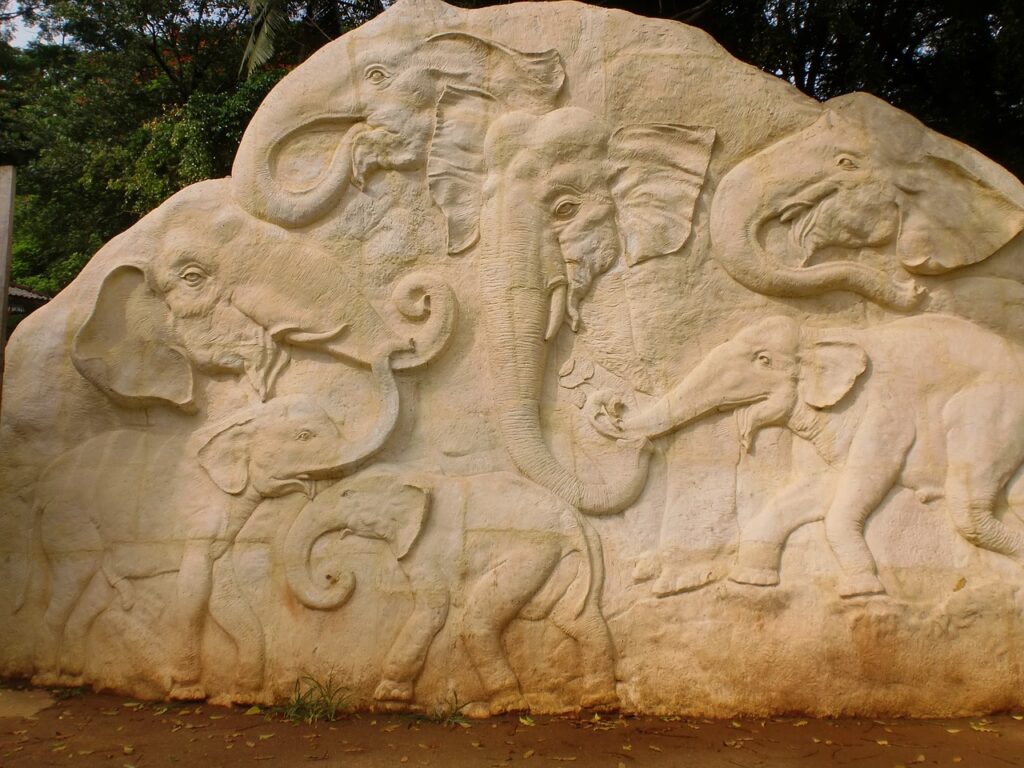Pinnawala Elephant Orphanage: A Sanctuary of Hope for Elephants in Sri Lanka

The Pinnawala Elephant Orphanage, situated in the tranquil and verdant village of Pinnawala, approximately 90 kilometers northeast of Colombo, is one of Sri Lanka’s most cherished wildlife conservation initiatives. It has gained international recognition for its commitment to caring for and protecting orphaned and injured elephants. Pinnawala, a symbol of Sri Lanka’s commitment to wildlife preservation, also provides visitors with the distinctive opportunity to observe and engage with elephants in close proximity.
This blog will focus on the history, mission, daily existence of the elephants, and conservation efforts of the Pinnawala Elephant Orphanage. This article will provide an exhaustive overview of the life and work of this extraordinary institution, whether you are a wildlife enthusiast, a traveler seeking an authentic experience, or an animal welfare enthusiast.
History and Foundation

The Sri Lankan Department of Wildlife Conservation established the Pinnawala Elephant Orphanage in 1975. Initially, its main goal was to provide care and shelter to orphaned elephants found in the wild. Human activities, natural disasters, or poaching separated many of these elephants from their populations. The orphanage grew in size and reputation, establishing itself as a prominent center for elephant conservation and care.
Pinnawala was initially located in Wilpattu National Park and consisted of only five infant elephants. However, logistical challenges led to the relocation of the elephant herd to Pinnawala, a rural village in the Sabaragamuwa Province. This new location offered a more favorable environment for the elephant herd to flourish. Additionally, the adjacent Maha Oya River, a critical resource for their daily activities, provided ample space for the elephants to roam and engage in interactions.
Mission and Objectives
The primary objective of the Pinnawala Elephant Orphanage is to offer care, rehabilitation, and protection to orphaned and injured elephants. It endeavors to provide a secure and nurturing environment that is free from the dangers of human encroachment, deforestation, and exploitation, allowing these magnificent creatures to recover and flourish.
In addition to its primary objective, Pinnawala highlights:
- Elephant breeding: Over the years, the orphanage has successfully bred numerous elephants, thereby contributing to the conservation of the endangered Sri Lankan elephant species.
- Research and education: The orphanage works in conjunction with conservation organizations, universities, and researchers to investigate the behavior, physiology, and welfare of elephants. It also raises public awareness and educates people about the importance of wildlife conservation.
- Tourism and sustainability: The orphanage is a tourist attraction that ensures that visitor engagement contributes to conservation efforts’ funding and supports the elephants’ well-being.
A Day in the Life of an Elephant at Pinnawala

Visitors to Pinnawala can observe the daily routine of the elephant population. We meticulously craft these activities to replicate the natural behavior of elephants in the wild while also accommodating their unique requirements.
Feeding in the Morning
- The day at Pinnawala commences with the feeding of the elephants, particularly the youngest ones. Visitors can observe and occasionally participate as the orphaned elephants receive bottle-fed milk. This educational and heartwarming activity shows the bond between animals and their caregivers. On the other hand, the mature elephants receive a substantial supply of fruits, leaves, and branches. A fully grown elephant can consume up to 150 kilograms of food per day, predominantly consisting of grass, fruits, and bark.
River Bathing Ritual
- Witnessing the elephants’ river bathing session is one of the most memorable aspects of any visit to Pinnawala. The elephants are transported to the Maha Oya River twice daily, where they spend several hours socializing, playing, and cooling off. These rituals help elephants stay healthy, clean, and behave naturally. Observing the livestock, particularly the young calves, splashing around in the river is a captivating sight and a favorite among visitors.
Afternoon Grazing
- After their river bath, the elephants return to the sanctuary and spend the afternoon grazing in the open fields. The elephants require this time to forage and exercise, which is crucial for their physical well-being. Visitors can observe them from a distance and appreciate theirmajesty and grace as they freely meander.
Caretaker-Elephant Bond
- The profound relationship between the elephants and their mahouts (caretakers) is one of the most remarkable features of Pinnawala. Each elephant’s maintenance, training, and well-being are the responsibility of the designated mahout. Trust, perseverance, and years of collaborative effort are the foundations of this relationship. Mahouts are adept at comprehending the behavior and requirements of their elephants, guaranteeing that they receive the highest quality of treatment.
Elephant Breeding at Pinnawala

Through its effective breeding program, the Pinnawala Elephant Orphanage has made substantial contributions to the conservation of the Sri Lankan elephant species. One of the most successful elephant breeding institutions in the world, the orphanage has given birth to more than 70 baby elephants since its inception.
We meticulously oversee the reproduction program to guarantee the health and genetic diversity of the elephants. The orphanage offers a secure environment for expectant elephants, enabling them to give birth naturally without any human intervention. The mothers and the broader population provide care for the infant elephants, enabling them to develop in a family-oriented environment.
Due to significant threats from human-wildlife conflict and habitat degradation, the success of the breeding program’s success has increased awareness of the importance of protecting Sri Lanka’s elephant population.
Challenges and Controversies
Pinnawala Elephant Orphanage has encountered numerous challenges and controversies, despite its commendable mission and accomplishments. Even in an environment as well-intentioned as Pinnawala, certain animal rights groups have expressed apprehension regarding the ethical implications of retaining elephants in captivity. Critics argue that rehabilitating and reintroducing elephants into the wild is preferable to keeping them in captivity for their entire lives.
In response to these concerns, Pinnawala’s management has implemented measures to improve the welfare of the elephants under their care. The orphanage has improved its facilities to provide the elephants with sufficient space to socialize, roam, and engage in their natural behaviors. Furthermore, they have instituted more stringent guidelines for interactions between visitors and elephants in order to prevent any stress or harm to the animals.
The orphanage faces another significant challenge in addressing Sri Lanka’s ongoing human-elephant conflict. Conflicts over land and resources have become more frequent as human populations continue to grow and encroach on traditional elephant habitats. This often leads to the injury or death of elephants, underscoring the importance of conservation initiatives like those at Pinnawala.
Conservation Efforts and Global Impact
The Pinnawala Elephant Orphanage is not merely a sanctuary for elephants; it is essential to global conservation initiatives. The orphanage works in conjunction with international wildlife organizations to exchange research findings, best practices, and knowledge regarding elephant care. It also engages in conservation awareness campaigns, emphasizing the imperative need to safeguard endangered elephants.
The orphanage’s success has provided inspiration for similar projects in other regions of the globe, particularly in countries that are grappling with comparable challenges such as habitat loss and human-elephant conflict. Pinnawala has contributed to a broader global movement aimed at protecting these magnificent creatures by serving as a model for elephant care and conservation.
Visiting Pinnawala: What to Expect
The Pinnawala Elephant Orphanage is an essential destination for travelers to Sri Lanka. The orphanage is accessible to the public year-round and provides a variety of experiences for visitors of all ages. During your visit, you can expect the following activities:
- Interactive Feeding Sessions: During their morning and afternoon feeding sessions, visitors have the opportunity to feed the newborn elephants. It is an excellent opportunity to observe these gentle creatures up close and acquire information regarding their diet and care.
- River Bathing Experience: As previously indicated, the twice-daily river bathing session is a highlight of any visit. Observing the elephants play and interact on the river is an unforgettable experience.
- Elephant Walk: During their journey from the orphanage to the river, visitors can accompany the elephants and observe their natural behaviors and interactions.
- Educational Exhibits: The orphanage offers informative displays and exhibits that cover the history of Pinnawala, elephant conservation, and biology. It is an invaluable tool for gaining insight into the significance of wildlife preservation.
How Pinnawala Contributes to Local Communities
The Pinnawala Elephant Orphanage is not only critical for elephant conservation, but it also makes a significant contribution to the local economy. The orphanage generates employment opportunities for local residents, including tour guides and vendors, by drawing thousands of tourists annually. We also use the tourism revenue to support the orphanage’s maintenance and conservation initiatives.
Additionally, Pinnawala has cultivated a sense of pride among the local community, as residents are actively involved in the preservation of one of Sri Lanka’s most iconic animals. The orphanage has become a symbol of optimism and resilience for the people who live and work in the region, not just elephants.
Conclusion
The Pinnawala Elephant Orphanage serves as a symbol of compassion and conservation for the elephants of Sri Lanka. Its mission to safeguard and restore neglected and injured elephants has earned it global recognition, and its endeavors have had a tangible impact on the preservation of this endangered species. Despite the obstacles it faces, the orphanage persists in its efforts to improve the quality of life for its elephants and raise awareness of the importance of wildlife conservation.






